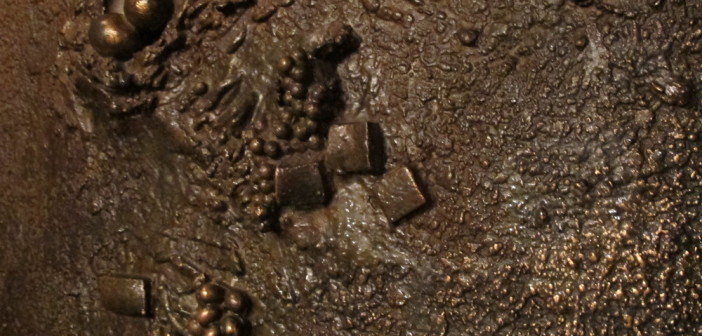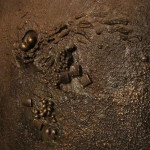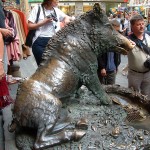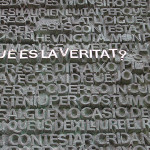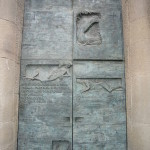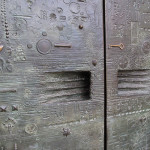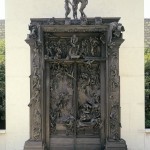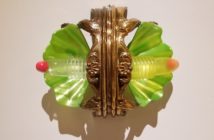As some upcoming (and more considered) articles will attest, I spent the holidays in Omaha, Nebraska. This, however, is the meatiest post of all: entering and leaving Johnny's Cafe, a fixture since the 20s on the Omahan steak house circuit, I had to lean into two rather large bronze double-doors, polished over the years by the hands of pilgrims, who've entered hungrily and left replete with carnal knowledge, as I did last Friday night. (Bad puns follow difficult digestion). It was probably the dirty martini that done it: it seemed a good idea at the time to photograph said door and compare it to another more predictably sacred entrance I'd admired earlier this year.

Consider the way we interact with monumental bronzes, caressing only the most symbolically charged details of their cool surfaces—John Harvard's left shoe, for instance—as the rest slowly oxidizes into patina. At Johnny's, aside from the shining door handles, which alone speak to the joint's popularity, the bull horns gleam with accumulated grease. Whether the preciousness of that specific surface is justified, or only made more alluring by its relative glow, is one way of pondering the birth of icons of faith or gastronomy.

I wonder if touching the horns has the same desired effect as stroking the snout of Il Porcellino, which promises the superstitious a return trip to Florence. Or maybe, there's a conqueror's appeal to petting an animal that so typically was considered wild. Petting it after you've eaten it, in this case. Saying you'll come back for more.
Nebraska ranks 3rd in beef production, after Texas and Kansas. Given our national obsession with meat—cow, bull, steer, heifer, 26 billion pounds of beef "harvested" in 2011—it's not much of a stretch to compare the steak house to a place of pilgrimage and communion, albeit one where excess and heartburn replace asceticism and meditation. Which brings me to those other doors that came to mind as I exited Johnny's Cafe: the massive bronze entrance on the Passion facade of Gaudí's Sagrada Família.

The Gethsemane Door is a treasure map of symbols. Is it surprising, knowing our human nature, to see that both heart and key are the most well-worn objects on the door? This quest for spiritual food comes from another kind of hunger: when entering a temple of solace, we look for answers, comfort, love, forgiveness. We also may seek perspective: ¿Què és la veritat? What is truth?

Crossing into each of these worlds, on two very different kinds of quests, the heft of the bronze doors stands as a rite of passage. We come to ingest, digest very different kinds of flesh. My apologies to all the vegetarians out there who I've disgusted with these thoughts. Your idea of the bronze door at Johnny's Cafe—which stands in the shadow of former stockyards—may be closer to Rodin's Gates of Hell.
- The bronze doors at Johnny’s Cafe, Omaha. (detail) Photo: Stephanie Cardon
- Pietro Tacca, Il Porcellino (1577-1640) Florence, Italy Photo: Radomił Binek, via Wikipedia
- Gospel Door on the Passion Facade at the Sagrada Família, Barcelona (detail)
- The Gethsemane Door on the Passion Facade at the Sagrada Família, Barcelona
- The Gethsemane Door (detail) Photo: Stephanie Cardon
- Auguste Rodin, The Gates of Hell Rodin worked on and off on this project for 37 years, until his death in 1917.

